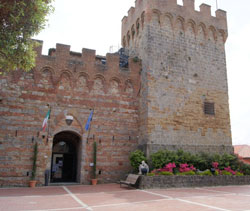VAL D'ELSA
Val d'Elsa, borrowing its name from the river Elsa, is located in the heart of Tuscany close to the cities of Siena, Florence and Volterra. Today it is mostly appreciated for its unspoiled nature and well known for the production of crystal glassware and art (15% of the worlds and 98% of Italy's production).
Book your accommodation, chosing between hotel, B&B, residence, farmhouse in Val d'Elsa!
We suggest to visit:
Colle Val d'Elsa
Colle Val d'Elsa is a village perched on a high hill and divided into two zones: "High Colle" and "low Colle".
The city is mentioned in the Italian history for the famous battle of Colle di Val d'Elsa that decreed the victory of the Florentine and Colle's Guelphs against Sienise Ghibellines. The battle took place between 16 and 17 June 1269.
Colle Val d'Elsa is the birthplace of Arnolfo di Cambio, to whom is dedicated the main square.
Colle Val d'Elsa is connected by bus to Florence and Siena.
Events in Colle Val d'Elsa:
Cristallo tra le mura
The event is dedicated to the crystal produced at Colle and takes place every year in the first three weekends of September. During the event, you can see demonstrations of crystal working with different techniques: hot, cold, carving, engraving and grinding. Besides this there are stands with food and wine, wine tasting and the opening of the extraordinary museums.
LiberaCollArte
Day's art: from 10 am until late at night there are stands with local and international crafts, theater, art installations, street musicians and a great final concert with famous artists of the Italian music scene.
LiberaCollArte is held every year in September.
Casole d'Elsa
 Casole d'Elsa is a medieval village that rises along the valley of the Elsa river.
Casole d'Elsa is a medieval village that rises along the valley of the Elsa river.
It's placed on a hill at 417m above sea level, from which you can enjoy a beautiful landscape of the Elsa Valley and the surrounding campaign.
Founded by Etruscans, it was controlled by the bishop of Volterra until the 13th century when, after a period of free municipality, fell under the Siena control after a long siege.
Despite several uprisings, Casole remained a Siena possession until 1554, when it was annexed to the Florence property under the rule of the Medici family. In this time an economic development started, and continued even under the Lorraine.
Among the several events taking place in Casole you will find the Palio di Casole, on the second Sunday of July (St. Isidore). This is a horse race, on a dirt road, with uphill. It 'a "long run" prize where the starting point does not match with that of arrival.
During the week before the Palio in the districts evening parties and dinners are organized.
Attractions: The Collegiate Church of Santa Maria Assunta, the praetorian palace, Rocca Senese (nowadays the town hall).
To get to Casole d'Elsa take the road Siena -Florence and exit Colle Val d'Elsa Nort, then turn left towards Casole d'Elsa (direction: Volterra).
San Gimignano
San Gimignano is a medieval village perched on a hill over 300m above sea level, famous for its towers dominating the whole valley.
The construction of the towers dates back from the 11th to the 13th century. In this period the economy was flourishing and the city was politically independent, the urban aristocracy that had formed in the city wanted to demonstrate their political and social supremacy, and building up 72 towers.
This prosperous period ended in 1300 after a major famine and the spread of Black Death, when San Gimignano gave up its independence and surrendered voluntarily to Florence.
14 of the ancient 72 towers are still standing, others are ruins, but still visible. The Torre del Podestà (also called Rognosa), 51 meters high, is the oldest. The Torre Grossa, for only 3 cm, is the highest.
Below is a list of the towers of San Gimignano:
- two Torri degli Ardinghelli
- Torre dei Becci
- Torre Campatelli
- Torre Chigi
- Torre dei Cugnanesi
- Torre del Diavolo
- Torre Ficherelli o Ficarelli
- Torre Grossa
- Torre di Palazzo Pellari
- Torre Pettini
- Torre Rognosa
- two Torri dei Salvucci
To these we can add two case-torri (towerhouses): the bell tower of the Collegiate and the Torre Pesciolini.
San Gimignano maintains its aspect reminding to 13 and 14 centuries and in 1990 the Old Town was been declared a UNESCO World Heritage Site.
If you are in Florence and want to visit Siena and San Gimignano we suggest you to visit: tour in Siena and San Gimignano




 English
English German
German French
French Spanish
Spanish Italian
Italian